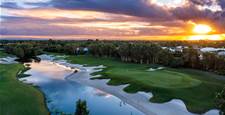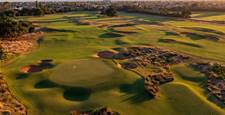Over the past two decades, northern Tasmania has emerged as a world-class golf destination offering a mix of internationally acclaimed layouts and fun, picturesque courses anyone can play.
Another good short par-4 is the 315-metre 6th, which presents a big sweeping dogleg left fairway that rises up and over the crest of a hill before descending to a green cut into the side of a hill. There is plenty of trouble down the right of the fairway with huge pine trees grabbing mis-hit drives while an out-of-bounds fence comes into play near the right edge of the green.
Perhaps the least known of the layouts easily reached from Launceston is the nine-hole gem at Quamby Estate, which is located a leisurely 25-minute drive from the city near the historic township of Hagley.
Built between 1828 and 1838, Quamby was the ancestral home of Sir Richard Dry,
the Premier of Tasmania for several years during the 1860s. Today, Quamby is a magnificent homestead boasting ten fully-restored guest rooms within the ambience of a boutique guesthouse.

Surrounding the homestead is the Peter Toogood-designed nine-hole course, which was named in 2019 as one of the nation’s Top-100 Nine-Hole Courses by Golf Australia magazine.
When played from the alternate tees used for an 18-hole round, Quamby measures 6,006 metres across a gently rolling landscape dotted with 170-year-old deciduous trees and hedges.
Built in the early 1990’s, the Quamby course provides enough width in the fairways and size in the greens to not overawe players by the challenge it presents. Arguably the best of the holes here is actually its shortest offering and Quamby’s only par-3 – the 158-metre 2nd, which plays marginally shorter as the 11th hole. The tee shot here must carry a lake and a huge bunker stretched across the front edge of the large putting surface.
Toogood’s Quamby design is a fun one but it is the outstanding presentation of the playing surfaces that you will remember most from your round.
Like Quamby, Greens Beach Golf Club is one of Tasmania’s finest nine-hole courses and is ranked in the best 100 short courses in the country.
A 70-minute drive north from Launceston, just west of the Tamar River mouth, Greens Beach is a pretty seaside hamlet of no more than 300 people with the links-style layout lying at its hub.

Greens Beach is a wonderful course that was built in 1950 – with little to no earth moved – which has remained largely unchanged for seven decades. Alternate tees, offering different angles of play to the fairway, have been added to create diverse holes, played to the same greens, from one nine-hole loop to another.
The natural ebb and flow of the fairways ensures there are few, if any, flat lies to play your approach shots. Despite the sandy soil that lies beneath these fairways, the bunkering is not overdone, even where an afternoon with a shovel would expose some wild sandy hazards. But the layout doesn’t need them.
There are 22 bunkers spread throughout the layout, with six of them surrounding the downhill par-3 6th/15th hole. From the slightly elevated tee, all half dozen sandy hazards lay in view wrapping in a semi-circle around the front of the putting surface. The only safe miss here is long and right of the green. Complicating the tee shot is the ever-present breeze and the linksland firm playing surfaces.
The club has recently started the process of remodelling its clubhouse to become a community sporting hub overlooking its greatest asset – a fun and challenging golf course.
Devonport Country Club, about 65km west of Greens Beach, has already completed an extensive $11 million upgrade of its clubhouse after the golf club merged with the Devonport Bowls and Croquet Club as well as the Spreyton Bowls Club.
The new club features a state-of-the-art sports centre, an international standard indoor bowls area, four grass greens and a two croquet courts, while the acclaimed Vern Morcom-designed course now includes a remodelled par-3 10th hole, crafted by Ocean Dunes creator Graeme Grant.
The new hole plays shorter than the original, whilst covering the same terrain, and still has the tidal Mersey River as a backdrop to the hole. Grant created a new green complex, with a pear-shaped putting surface protected by three small pot-like bunkers and a more expansive sandy hazard. Narrow at the front and wide at the back, the green is only a few metres from scrub on the edge of the riverbank.

There are future plans for Grant to return the layout to its Morcom design origins, with the shape and positioning of bunkers across the course set to be remodelled.
Devonport has long been regarded as one of the best courses in Tasmania. A regular host of the Tasmanian Open and Amateur, it is an unpretentious beauty. The visitor drives down an ordinary country lane, through narrow gates into an almost park-like setting. It belies the challenge that lies ahead and it is not until you step onto the 1st tee that you can really appreciate the strength and beauty of this layout.
The opening hole – a 386-metre par-4 – is one of Devonport’s best. The fairway bends slightly to the left and calls on you to drive down the right side to leave an unobscured long approach to the green.
This is a traditional bushland course so trees tightly flank many of the fairways, making birdies hard to come by. With most greens elevated slightly with steep slopes off each side, chipping and putting can also be tricky.
All these elements come into play on the toughest of all Devonport’s holes – the 404-metre par-4 6th. This gentle dogleg right has a thick row of trees covering the left edge of the fairway while an innocuous looking bunker lies just 50 metres from the putting surface, ready to catch the duffed or slightly miscued approach shot. The green is large and receptive but off line shots are repelled away by steep slopes into thick rough.
Deception is one of Devonport’s defences as there are several holes where the correct line and length into the green only becomes clear once you have reached the putting surface.
Related Articles

Drinks With... Ricky Ponting

Barnbougle Dreamin': They built it, they came, they're still coming



.jpg&h=115&w=225&c=1&s=1)




_15th_hole.jpg&h=115&w=225&c=1&s=1)




